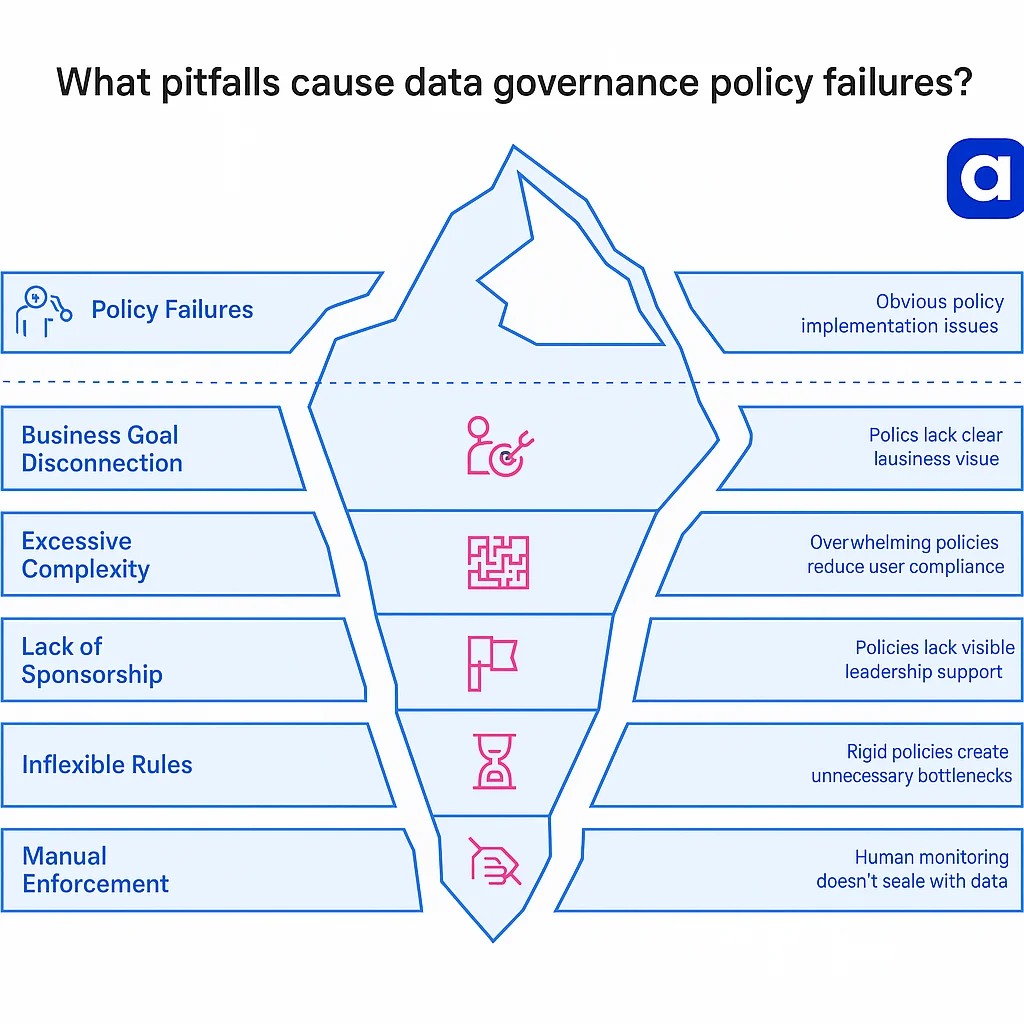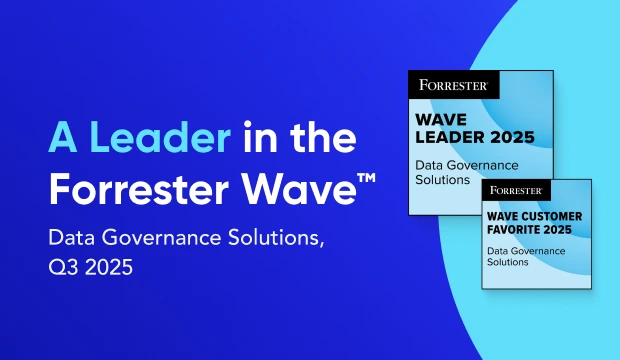What are the five essential sections of a data governance policy? #
Summarize and analyze this article with 👉 🔮 Google AI Mode or 💬 ChatGPT or 🔍 Perplexity or 🤖 Claude or 🐦 Grok (X) .
1. Purpose and scope #
Define exactly what you’re governing and why it matters to your bottom line. This section answers the critical questions that prevent scope creep and ensure stakeholder buy-in.
What to include:
- Specific business objectives (improve data quality for ML models, ensure GDPR compliance, reduce security risks)
- Precise data boundaries: “Customer PII in production databases” not “customer information”
- Clear exclusions to prevent mission creep
- Direct connection to revenue impact or risk mitigation
Why data teams struggle here: Vague scope statements create endless debates about what’s covered. Be ruthlessly specific about boundaries to prevent teams from making costly assumptions about policy coverage.
2. Roles and responsibilities #
Clear ownership prevents the “not my job” syndrome that kills governance initiatives. This section eliminates confusion about decision-making authority and daily execution.
Essential role definitions:
- Data Governance Council: Strategic oversight and policy approval
- Chief Data Officer/Data Leader: Business alignment and resource allocation
- Domain Data Stewards: Day-to-day quality and access decisions
- Data Custodians: Technical implementation and maintenance
- Data Users: Consumption responsibilities and escalation procedures
Critical success factor: Map each data lifecycle stage to specific roles. Who approves new data sources? Who resolves quality issues? Who grants access permissions? Federated models work best—domain teams own quality while central teams maintain standards.
3. Data standards and definitions #
This section eliminates the chaos of conflicting metrics across teams. Without shared definitions, your organization creates parallel versions of truth that undermine decision-making.
Core components:
- Business glossary: Official definitions for key terms and metrics
- Quality thresholds: Specific accuracy, completeness, and timeliness requirements
- Naming conventions: Consistent dataset and field naming across systems
- Classification schemas: Sensitivity levels (public, internal, confidential, restricted)
- Master data hierarchies: Authoritative sources for customers, products, locations
Real-world impact: When marketing’s “active customer” definition differs from finance’s, executive dashboards show conflicting numbers. Standardized definitions prevent these trust-destroying scenarios.
4. Procedures and workflows #
Transform policy statements into step-by-step processes your teams can execute without interpretation. This section bridges the gap between governance theory and daily operations.
Essential workflows:
- Data access requests: Clear approval paths with defined timeframes
- Quality issue escalation: Who to contact when data breaks
- New dataset onboarding: Security, quality, and documentation requirements
- Change management: How to modify existing data structures safely
- Exception handling: When and how to deviate from standard procedures
Implementation keys: Include specific timeframes (“48-hour approval SLA”), required documentation, and automated workflow triggers where possible. Teams need processes they can follow without constant clarification requests.
5. Compliance and enforcement #
Without teeth, your policy becomes expensive documentation. This section defines how governance translates into measurable outcomes and behavioral change.
Enforcement mechanisms:
- Automated monitoring: Real-time policy violation detection
- Audit schedules: Regular compliance verification
- Training requirements: Role-specific governance education
- Violation consequences: Progressive responses from warnings to access removal
- Success metrics: Measurable governance effectiveness indicators
Modern approach: Shift from punitive to enabling enforcement. Build policy checks into existing workflows rather than creating separate compliance processes. Focus on making compliance easier through automation rather than relying on manual oversight.
What are the core components of the data governance policy? #
Before writing your comprehensive policy, understand the specific components that form a complete governance framework. Each addresses different aspects of data management:
1. Data Quality Policy: Ensures your data is accurate, complete, and reliable for business decisions by tracking quality metrics.
2. Data Privacy Policy: Protects personal information and ensures compliance with GDPR, HIPAA, and privacy regulations.
3. Data Security Policy: Controls who can access your data and how it’s protected from breaches.
4. Data Lifecycle Policy: Defines when to keep, archive, or delete data throughout its lifespan.
5. Data Ethics Policy: Ensures responsible data use that aligns with your company values, especially for AI projects.
6. Data Definitions and Models: Creates a shared vocabulary so everyone uses the same terms and metrics.
How do I write a data governance policy in 2025? #
Modern data teams need policies that enable innovation, not create bottlenecks. Here’s your streamlined approach:
1. Assemble the right team: Include business domain experts, technical architects, compliance specialists, an executive sponsor, and actual end users. The biggest failures happen when governance teams write rules without input from people who use data daily.
2. Assess existing practices: Document what’s working before writing new rules. Map current workflows, identify pain points through team interviews, and review recent incidents. Build on existing strengths rather than starting from scratch.
3. Connect to business outcomes: Quantify the ROI of governance—calculate costs of poor data quality, show how governance accelerates AI initiatives, and demonstrate competitive advantages. Example: “Accurate customer contact data improves email ROI by 23%.”
4. Draft in plain language: Write for business users, not data engineers. Use concrete examples, maintain logical organization, and keep policies to 10-15 pages maximum. Complex documents get ignored regardless of technical merit.
5. Build in flexibility: Create tiered governance based on data sensitivity, establish clear exception processes, and plan quarterly reviews. Rigid policies become bottlenecks that teams circumvent through shadow IT.
6. Plan for implementation: Include phased rollout timelines, role-specific training programs, required tools, and success metrics. The best policies create direct paths from documentation to daily practice.
What data governance policy template can I use for quick drafting? #
If your organization is in the early stages of establishing best practices and standards around data, knowing where to start with your data governance policy can be challenging. Here are some publicly-available data governance policies you can use as models for your own:
- Oklahoma Office of Management & Enterprise Services offers comprehensive policy coverage with specific focus on governance roles and responsibilities.
- New Hampshire Department of Education provides detailed job duties for key individuals and outlines intended policy outcomes for measuring success.
- University of New South Wales Sydney demonstrates the multi-policy approach, separating standard data governance from research data governance for distinct requirements.
- East Carolina University showcases concise yet comprehensive coverage—scope, roles, and accountability in a short, precise document.
- Brandeis University ties every data source to a specific “data trustee,” ensuring complete ownership coverage across the data estate.
- University of Nevada Las Vegas includes comprehensive sections on data access, usage, and integrity standards.
Choose the template that best matches your organizational communication style and goals, or combine strengths from multiple examples.
Who approves and enforces the data governance policy? #
Successful data governance requires clear roles for both approval and enforcement:
Approval authority #
Data governance policies typically follow a hierarchical approval path:
- Data Governance Committee: Reviews and recommends
- Executive sponsor (often CDO or CIO): Validates business alignment
- Board of Directors/Executive Leadership: Gives final approval for enterprise-wide policies
For domain-specific policies, approval might stop at the department head level, while enterprise policies affecting multiple departments require C-suite sign-off.
Enforcement responsibility #
The enforcement model typically includes:
- Data stewards: Monitor adherence in their domains
- Data governance office: Coordinates enforcement activities
- Automated systems: Flag policy violations in real-time
- Audit teams: Periodically verify compliance
- IT security: Enforce access-related policies
Modern organizations are shifting from punitive enforcement to supportive enablement, focusing on making compliance easier through automation and education rather than penalties.
The most successful enforcement models implement what Gartner calls “just-in-time governance” — embedding policy checks directly into workflows where data is created or accessed rather than as separate processes.
How does the policy align with GDPR, CCPA, SOC 2? #
Effective policies must harmonize with regulatory frameworks:
GDPR alignment requires addressing data subject rights, lawful processing basis, impact assessments, breach notifications, and data minimization principles.
CCPA/CPRA alignment needs consumer access and deletion rights, opt-out mechanisms, service provider requirements, and data inventory maintenance.
SOC 2 alignment covers access controls, change management, risk assessments, monitoring requirements, and incident response protocols.
Create policy frameworks that accommodate the strictest requirements while enabling region-specific variations. Map policies to specific regulatory requirements for clear compliance traceability.
What pitfalls cause data governance policy failures? #

What pitfalls cause data governance policy failures? - Image by Atlan.
How do modern platforms automate policy controls? #
Manual policy enforcement can’t keep pace with the volume, velocity, and variety of data in modern organizations. Automation is essential for effective governance at scale.
Teams that need real-time lineage tagging and automated enforcement can layer a managed platform like Atlan over existing data stores. Atlan connects governance policies directly to data assets, creating a bridge between written guidelines and operational systems. This enables automatic policy application based on data sensitivity, lineage, or usage patterns.
Real stories from real customers: Transforming policy into practice #

Modernized data stack and launched new products faster while safeguarding sensitive data
“Austin Capital Bank has embraced Atlan as their Active Metadata Management solution to modernize their data stack and enhance data governance. Ian Bass, Head of Data & Analytics, highlighted, ‘We needed a tool for data governance… an interface built on top of Snowflake to easily see who has access to what.’ With Atlan, they launched new products with unprecedented speed while ensuring sensitive data is protected through advanced masking policies.”

Ian Bass, Head of Data & Analytics
Austin Capital Bank
🎧 Listen to podcast: Austin Capital Bank From Data Chaos to Data Confidence
Join Data Leaders Scaling with Automated Policy Controls
Book a Personalized Demo →
53 % less engineering workload and 20 % higher data-user satisfaction
“Kiwi.com has transformed its data governance by consolidating thousands of data assets into 58 discoverable data products using Atlan. ‘Atlan reduced our central engineering workload by 53 % and improved data user satisfaction by 20 %,’ Kiwi.com shared. Atlan’s intuitive interface streamlines access to essential information like ownership, contracts, and data quality issues, driving efficient governance across teams.”
Data Team
Kiwi.com
🎧 Listen to podcast: How Kiwi.com Unified Its Stack with Atlan

One trusted home for every KPI and dashboard
“Contentsquare relies on Atlan to power its data governance and support Business Intelligence efforts. Otavio Leite Bastos, Global Data Governance Lead, explained, ‘Atlan is the home for every KPI and dashboard, making data simple and trustworthy.’ With Atlan’s integration with Monte Carlo, Contentsquare has improved data quality communication across stakeholders, ensuring effective governance across their entire data estate.”

Otavio Leite Bastos, Global Data Governance Lead
Contentsquare
🎧 Listen to podcast: Contentsquare’s Data Renaissance with Atlan
Ready to publish your data governance policy? #
A well-crafted data governance policy transforms how your organization treats data as a strategic asset. By following the templates and avoiding common pitfalls outlined above, you can create guidelines that enable rather than restrict your teams. Remember that effective governance isn’t about perfect documentation—it’s about creating the right balance of control and enablement.
Join Data Leaders Scaling with Automated Policy Controls
Book a Personalized Demo →FAQs about data governance policy #
What are the key components of a data governance policy? #
A data governance policy typically includes purpose and scope, applicability, definitions, responsible stakeholders, exceptions, and related policies. These components ensure clarity and accountability in data management practices.
How can I implement a data governance policy in my organization? #
To implement a data governance policy, start by assessing existing policies, identifying key stakeholders, and drafting a collaborative document. Ensure that the policy aligns with business objectives and establish a framework for monitoring compliance.
What is the difference between data governance and data policy? #
Data governance refers to the overall management of data availability, usability, integrity, and security. In contrast, a data policy is a specific guideline or rule that governs how data should be handled within the organization.
How does a data governance policy support data privacy regulations like GDPR? #
A data governance policy helps organizations comply with data privacy regulations by establishing clear guidelines for data handling, access control, and accountability. It ensures that data is managed in a way that protects individual privacy rights.
What are the benefits of having a data governance policy? #
Having a data governance policy enhances data quality, ensures compliance with regulations, improves decision-making, and fosters trust in data. It also clarifies roles and responsibilities, leading to more effective data management.














